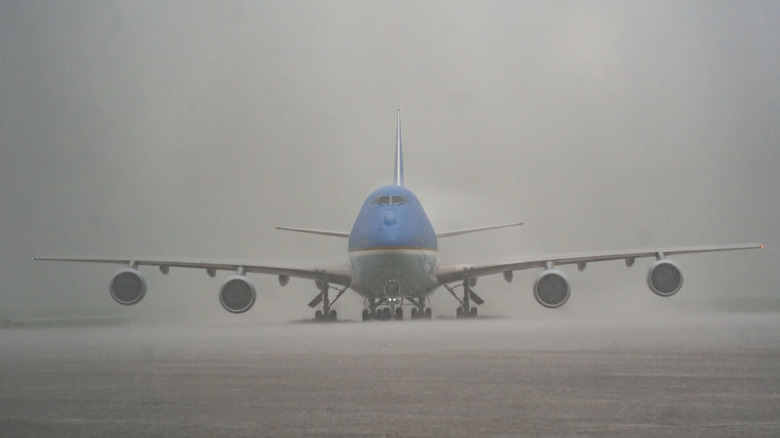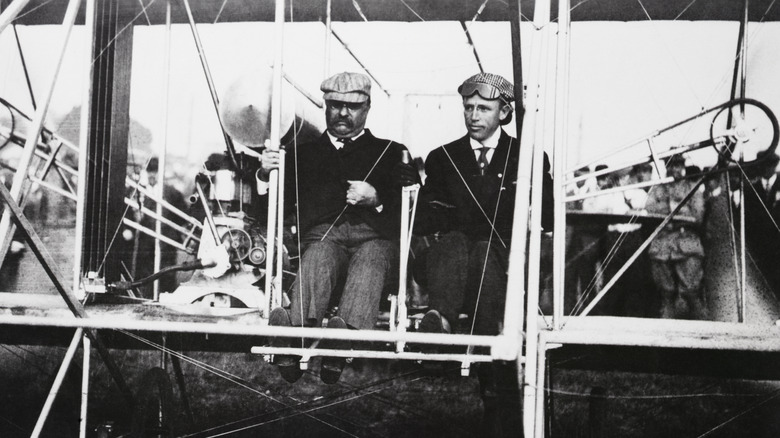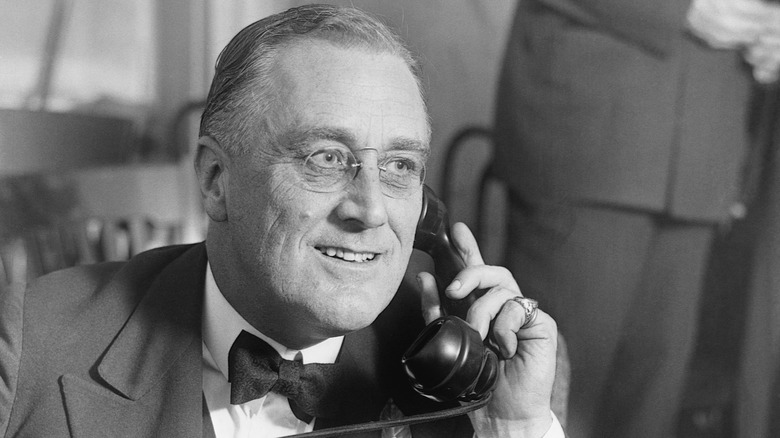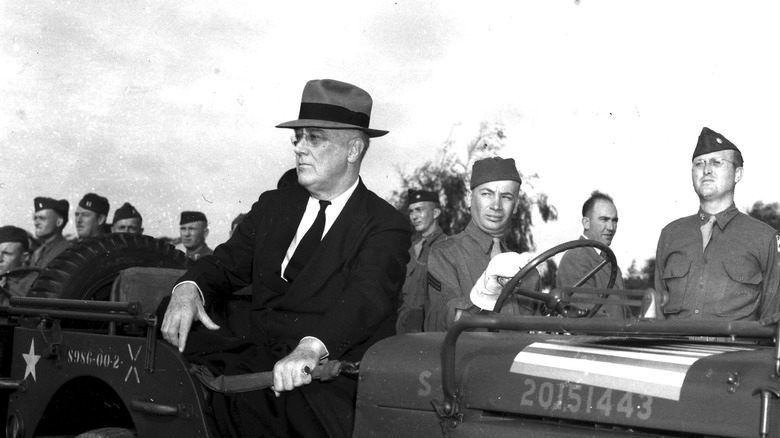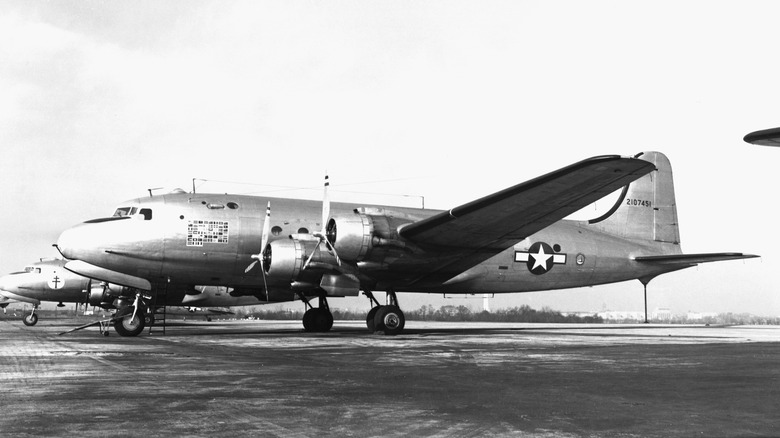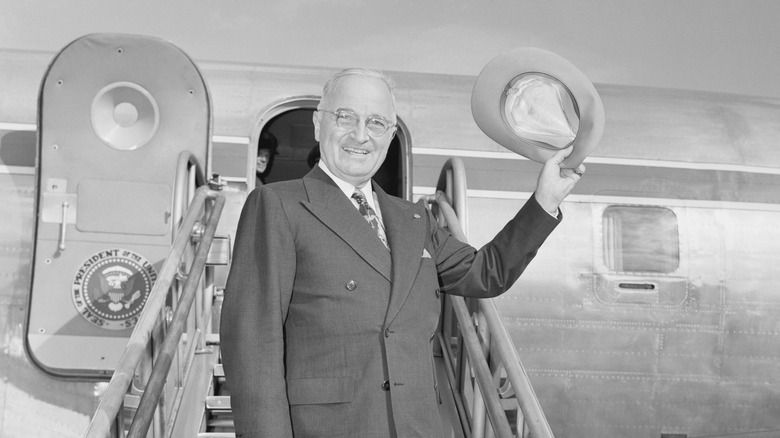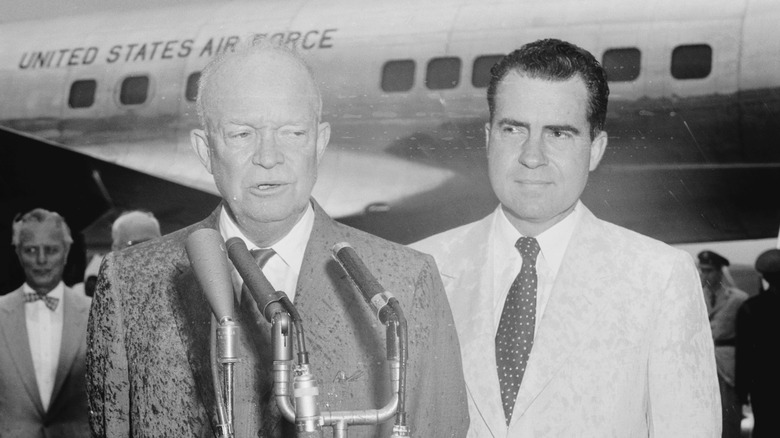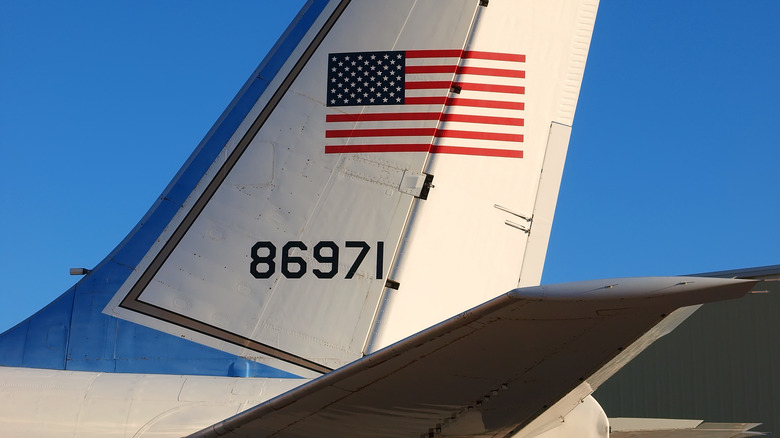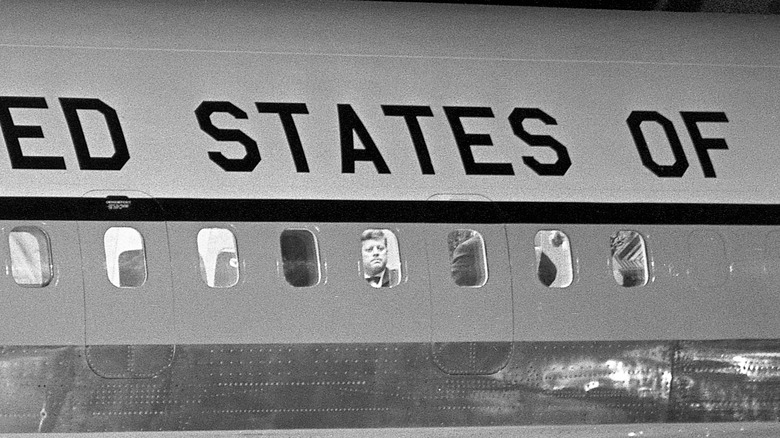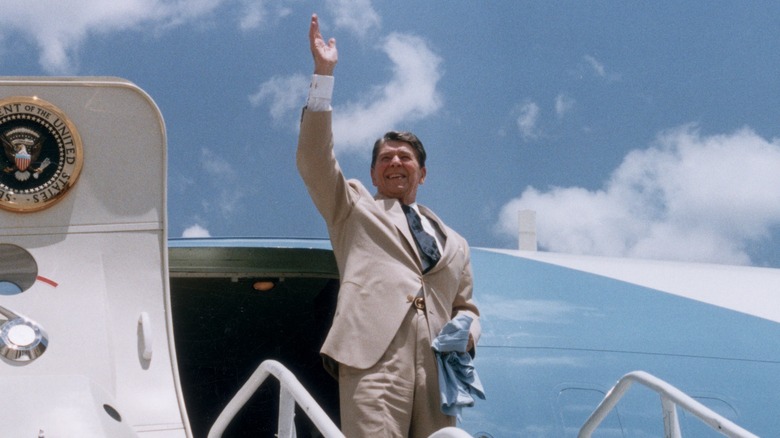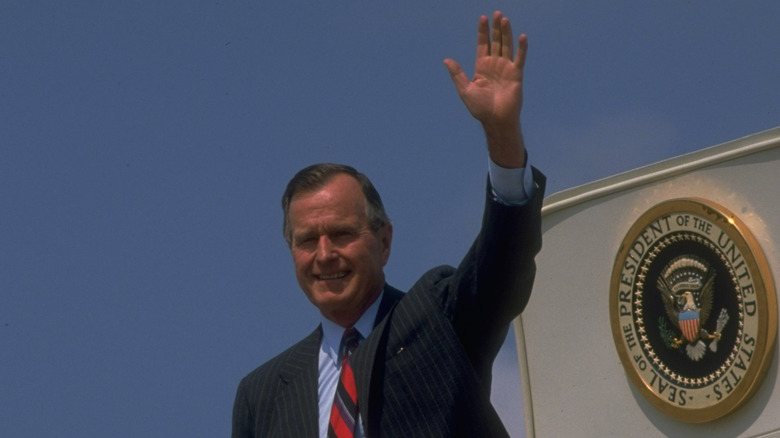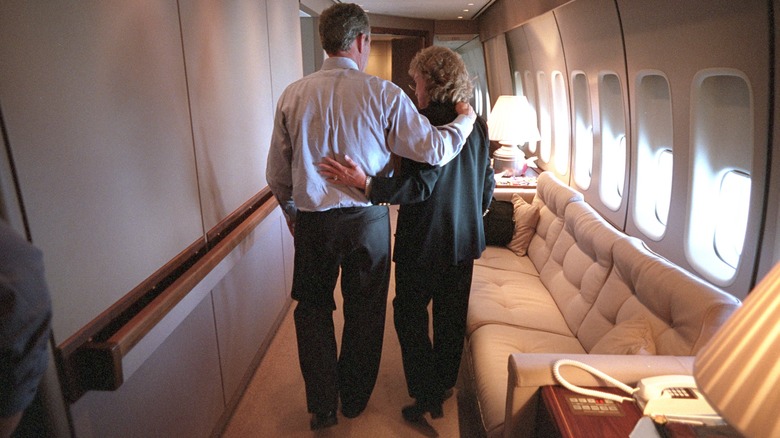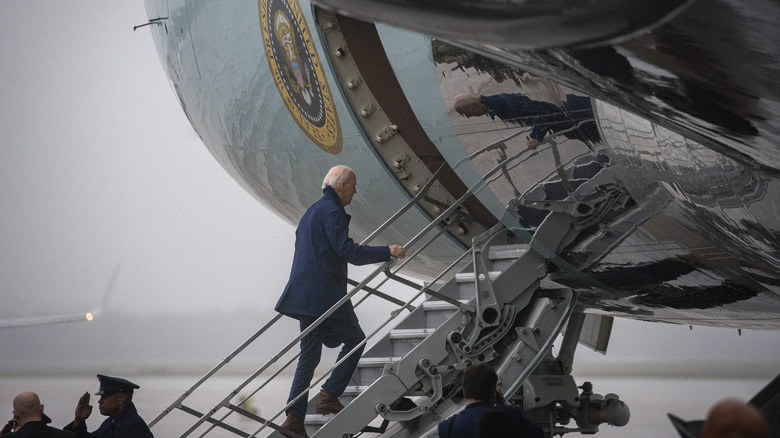The History Of Presidential Aircraft From Roosevelt To Biden
In the annals of American history, there exists a unique and iconic symbol of presidential power and prestige that soars above all others — Air Force One. This magnificent aircraft, often shrouded in mystery and intrigue, is not just a mode of transportation for the Commander-in-Chief; it is a symbol of American leadership, security, and the embodiment of airborne technological prowess.
For the vast majority of American history, the idea of a flying machine was nothing more than a fantasy, not even remotely possible. However, as time has gone by, the world of today has been molded and flying is now commonplace. Just as technology advances with the times, so has the technology driving the famous presidential aircraft. The story of Air Force One is a lengthy tale that spans nearly a century of American history, showcasing the evolution of presidential aviation from humble beginnings to the pinnacle of technological sophistication.
First president to fly
Just as the 20th century dawned, a new age of mankind was dawning. Near the end of 1903, Wilbur and Orville Wright accomplished a previously insurmountable task that would alter the course of humanity for the next century and beyond. On December 17, 1903, the Wright brothers took flight in their flying machine.
The dream to touch the sky was a dream no longer, and it was only a matter of time until the President of the United States grasped the import of the development. Nearly a decade after the Wright brothers took the first flight in human history, former President Theodore Roosevelt became the first President to ever fly.
At the time, Roosevelt had been out of office for over a year. At a county fair in St. Louis, Missouri in 1910, President Roosevelt was flown over the crowd. Although a rather inconspicuous occasion, this would be the historic first for presidential air travel. The brief trip was made in a Wright Flyer by Archibald Hoxsey, who himself worked for the Wright Brothers. The Wright Flyer is the comparatively primitive airplane the Wright Brothers designed to enable air travel. The first airplane was born of the Wright Brothers' experimentation with gliders, which ultimately led them to attach a propulsion system.
After President Roosevelt's flight, presidential aviation didn't really pick up any momentum for over two decades. Although Theodore Roosevelt was the first president to ever take to the sky, it would be his distant cousin, Franklin Delano Roosevelt, who would be in office for the birth of presidential air travel as we know it today.
President Roosevelt and RD-2
Though Theodore Roosevelt was the first president to ever fly in a plane, FDR was the first to ever fly in a plane while in office. In 1910, aviation simply wasn't safe enough to risk sticking the current president on an airplane. However, by the 1930s, the technology was ready. The first plane ever to be designated specifically for the travel of the president was an amphibious aircraft that was given the designation of "RD-2." To make the craft ready for presidential travel, the cabin of the plane was fitted with a desk, and a two-way radio.
The craft itself was a Douglas Dolphin, one of only fifty-eight that were ever built. Up to the point in time that the RD-2 was designated for use by President Roosevelt, presidents had usually traveled via a yacht called "Mayflower." In another interesting coincidence to do with both of the Roosevelts in this story, the Mayflower began its tenure as a presidential yacht during Theodore Roosevelt's presidency. Though the Mayflower was replaced during President Roosevelt's time in office, the yacht had actually been decommissioned years earlier by President Herbert Hoover. On decommissioning the Mayflower in 1929, President Hoover explained that the maintenance cost of the ship was $300,000 yearly. Adjusted for inflation, that's well over $5 million that was being spent annually on the upkeep of the Mayflower.
With a new vehicle in place for presidential travel, the RD-2 served its purpose for President Roosevelt for the majority of his first two terms in office, with usage of the RD-2 officially ending in 1939. Near the end of his second term, President Roosevelt's time in the air was about to drastically change as the world was set on the path to war.
World War II
On the first of September 1939, Germany under the rule of Adolf Hitler invaded Poland, which is widely considered to be the start of the Second World War. With war beginning, traveling to and within Europe quickly became a grave task. In particular, the threat of German submarines in the Atlantic made traveling to Europe by sea incredibly dangerous, nearly impossible. However, American diplomats needed to be able to get to and from Europe more than ever. Luckily, a solution was already on the way.
In the mid-1930s, Pan American World Airways called on engineers across the country to design a plane that could transport people and packages across the Atlantic. Eventually, the competition saw Boeing come out as the winner. From there, Boeing was contracted to build twelve planes in all. The plane made by Boeing was the 314 Clipper, a "flying boat." At 106 feet long, with a 152-foot wingspan, the Boeing 314 weighed 40 tons. But the Clipper could do exactly what it was built to do: transport passengers across the Atlantic by air.
The Dixie Clipper was one of the twelve Boeing 314s constructed under this contract. The craft was used to transport diplomats and foreign dignitaries out of Europe and out of the path of the Nazis during the start of the war. The Dixie Clipper's most significant trip came in transporting President Roosevelt to the Casablanca Conference in 1943, where he and British Prime Minister Winston Churchill discussed the Allies' strategy for World War II. The trip required multiple stops and took more than two days to make, one way.
The Guess Where II and the Sacred Cow
During this time, the U.S. Military had some concerns about the president using commercial aircraft for transport. Subsequently, the order was put out that a military aircraft be converted to accommodate use by the president. The craft proposed for this use was a C-87A, which itself was something of an offshoot of the B-24. That fact, in and of itself, is one of the reasons that the modified C-87, designated as the Guess Where II, didn't make the cut, as there were concerns that it could be mistaken for the B-24 and therefore be seen as a combatant craft. This wouldn't be an issue with a plane that was designed strictly for transport.
The second craft to be considered was a Douglas C-54 Skymaster. A craft was selected and reconfigured for presidential use, including a sleeping area, a phone, and an elevator to lift President Roosevelt while in his wheelchair. The aircraft was dubbed the "Sacred Cow." Unfortunately, President Roosevelt only ever took one flight in the Sacred Cow, in February 1945, just two months before his death.
After assuming office, President Harry S. Truman made extensive use of the Sacred Cow. In 1947, President Truman signed the National Security Act of 1947 into law while aboard the Sacred Cow. The signing of the act resulted in the creation of the Air Force, making the Sacred Cow the birthplace of the Air Force.
Truman and the Independence
Around the time the National Security Act of 1947 was signed into law, plans were already in place to replace the Sacred Cow. Ultimately, the Sacred Cow was replaced by a Douglas VC-118. The plane would be nicknamed the "Independence," after President Truman's hometown of Independence, Missouri. After its retirement as a presidential aircraft, the Sacred Cow remained in use by the Air Force. The Sacred Cow was ultimately retired in 1961 and is currently on display at the National Museum of the United States Air Force in Dayton, Ohio.
President Truman's Independence was the first presidential aircraft to be painted with distinctive markings, which included a bald eagle on the nose of the plane. The Independence included a stateroom and cabin made to seat 24 passengers. Like the Sacred Cow before it, the Independence was retired and is now on display at the National Museum of the United States Air Force.
Columbine II, the first Air Force One
Stepping up the pace of innovation, President Dwight D. Eisenhower introduced four new aircraft to presidential service during his time in office. Among these crafts were two Lockheed VC-121 Constellations. The planes were named the Columbine II by First Lady Mamie Eisenhower, after the state flower of her adopted home state of Colorado.
The Columbine II is of great historical import, as it was the first presidential craft to use the call sign "Air Force One." The Air Force One designation was put in place in 1953 after a commercial flight crossed paths with a plane carrying President Eisenhower. Air Force One was primarily used as an informal term until it became official nearly ten years later in 1962.
The Columbine II was retired by the end of 1954, making it the only Air Force One that was used by one president. Like others before it, the Columbine II was reassigned by the Air Force before ultimately being retired in 1968. Unlike its predecessors, the Columbine II ended up in private hands after an auction in 1970 and it eventually landed in a boneyard in Tucson, Arizona in 2003. The Tucson boneyard would remain the Columbine II's home until 2015, when a team from Dynamic Aviation began restoration work on the Columbine II. The restoration of the Columbine II is still ongoing.
Boeing 707, Special Air Mission
Toward the start of 1959, Secretary of State John Foster Dulles raised the concern to President Eisenhower that a propeller-driven aircraft might not be fit for presidential use anymore. This suggestion was, in no small part, due to Soviet Premier Nikita Khrushchev's transport being a more advanced, turboprop-powered Tupolev Tu-114. In turn, three Boeing 707-120s were acquired by the Air Force for government use. The three planes were given the designations of Special Air Missions (SAM) 970, 971, and 972.
The newly introduced 707s ushered in a marked improvement in presidential travel speed. Before President Eisenhower had the chance to fly in one, Vice President Richard Nixon was transported in one to the Soviet Union for his infamous debates with Khrushchev in 1959. One month later, President Eisenhower completed the first presidential flight aboard a jet. Also at this time, President Eisenhower became the first president to fly in a helicopter. During a diplomatic trip in December of 1959, President Eisenhower visited thirteen nations within the space of a month, a trip that would've taken double the time in a propeller-driven aircraft.
The three planes would eventually be bumped out of their roles as presidential crafts early in the 1960s. SAM 970 is now on display at the Museum of Flight in Seattle, Washington. SAM 971 would go on to one more famous flight when it was used to return American hostages during the Iran hostage crisis in 1981. It is also on display but at the Pima Air and Space Museum in Tucson, Arizona. Unlike the other two, the SAM 972 was scrapped in 1996.
SAM 26000
The SAM 970, 971, and 972 were all three set aside in favor of the SAM 26000. The SAM 26000 was a specialty-built Boeing VC-137C Stratoliner. The SAM 26000 hadn't been modified for presidential use when President John F. Kennedy was sworn in in 1961. At the behest of First Lady Jackie Kennedy, the plane was redesigned with blues and the presidential seal. The newly redesigned SAM 26000 entered use in October 1962 and quickly became an icon of the administration.
A little over a year after the SAM 26000 began seeing extensive use, President Kennedy was assassinated. Vice President Lyndon B. Johnson took the oath of office on the SAM 26000, which he soon ordered to carry President Kennedy's body back to Washington from Texas. President Johnson would go on to get extensive use out of the SAM 26000, at home and abroad. Ten years after President Kennedy's assassination, President Johnson's passing saw the SAM 26000 transport his remains from Washington to Texas.
The SAM 26000 went on to see extensive usage during President Nixon's time in office, with the jet being his transport for his famous trip to China in 1972, and another trip to the Soviet Union the next year. President Nixon would go on to call the Sam 26000 the "Spirit of '76," to commemorate the upcoming bicentennial of the United States.
SAM 27000
In December of 1972, the SAM 26000 was succeeded by the SAM 27000. The SAM 26000 didn't exit executive use, however, as it served as a backup for the SAM 27000 until its retirement in 1998. With President Nixon aboard, the SAM 27000 was involved in an incident over Syria when the Syrian government sent two fighter jets to escort Air Force One. There was a problem, however, as the pilot had not been informed this was going to happen. Thinking Air Force One was under attack, the pilot took evasive action before eventually being informed by the Air Force that the jets were there as escorts. President Nixon apparently remained calm through the ordeal.
When President Nixon resigned the presidency after the Watergate scandal, he was flown to California aboard the SAM 2700, which entered the air with the call sign "Air Force One." In the midst of the flight, President Gerald Ford was sworn in. Since the president was no longer on board the plane, the call sign was redesignated to "SAM 27000" mid-flight.
Throughout the 1980s, SAM 27000 saw its most extensive use under President Ronald Reagan, who took the craft on over two hundred diplomatic missions. The SAM 27000 served all the way from President Nixon until the administration of President George W. Bush. The SAM 27000 was retired in 2001 and is now on display at the Ronald Reagan Presidential Library.
SAM 28000 and 29000
Though there was no change to Air Force One during President Reagan's time in office, the process of crafting the successor to the SAM 27000 began during his presidency. In 1985, the Air Force requested two new craft. Delivered were two Boeing VC-25s, completed in 1986, but problems with wiring delayed the delivery of both crafts until 1990, during the presidency of George H.W. Bush. Upon delivery, the two crafts were designated as the SAM 28000 and the SAM 29000.
The new aircraft were the most technologically advanced presidential aircraft to date, with the ability to carry seventy passengers, and the addition of everything needed for the plane to serve as a mobile command center in the event of a nuclear strike. The jets are fitted with multiple defense measures, including infrared jammers and shielded wiring. Other defense measures of the jets are still classified. On occasion, either craft can be used for transporting the Vice-President. During this time, they take on the call sign "Air Force Two."
9/11
During the September 11 terrorist attacks in 2001, President Bush was famously informed of the attacks in the midst of reading a book to elementary school students in Florida. After being informed, President Bush departed Florida aboard Air Force One. However, air traffic controllers gave the jet a warning that a passenger jet was near Air Force One and that it was unresponsive to calls.
Colonel Mark Tillman, the pilot of Air Force One at the time, later recalled that there was no sense of what the capabilities of the terrorists were at that point in time. Col. Tillman flew Air Force One over the Gulf of Mexico to see if the passenger jet was following Air Force One, but it was not. The incident was later explained by the other jet having lost its transponder. However, that wouldn't be the last incident of the day, as Vice-President Dick Cheney sent along word that "Angel was next." Plans to take the president back to Washington were aborted, and Col. Tillman took President Bush to an Air Force base in Nebraska. After the fact, the White House was unable to confirm any evidence of a threat made against Air Force One on September 11. The investigation found that the ominous warning from the vice-president was a miscommunication.
The future
To this day, SAM 28000 and 29000 remain in use as Air Force One. Just this year, President Joe Biden visited Ukraine. During the flight over, to increase secrecy and security, the jet carrying President Biden did not use the call sign Air Force One, but rather "SAM060." As for the future of Air Force One, in September 2020, the Air Force announced that several contracts had been signed to move forward with several manufacturers developing supersonic aircraft. Of the supersonic crafts developed, one of the new planes could serve as Air Force One.
For the past eight decades, the President of the United States has been flown aboard bleeding-edge aircraft. Air Force One stands as a symbol of American strength and diplomacy, shuttling presidents across the globe to meet with world leaders and address critical matters of state. Its story is a testament to the nation's commitment to safeguarding its highest office and to harnessing the marvels of aviation technology. Looking toward the future, none of that seems to be changing anytime soon.
